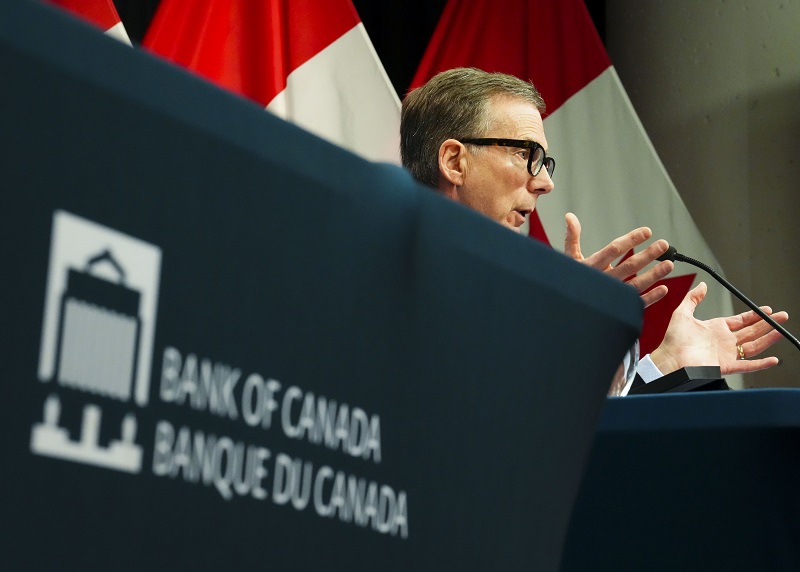Bank of Canada expected to hold interest rate one year after aggressive cycle began

OTTAWA – One year after the Bank of Canada’s aggressive rate hike cycle began, economists widely expect the central bank will stick to its plan of holding its key interest rate steady at its next scheduled announcement.
In making its rate decision next week, the central bank likely feels assured about its move to pause rate hikes, said Karyne Charbonneau, given recent economic data showing inflation is trending downward and the economy has slowed.
“They wouldn’t want to announce a pause and then immediately not go through with (it),” said Charbonneau, CIBC’s executive director of economics.
Since last March, the central bank has raised its key rate from near-zero to 4.5 per cent, the highest it’s been since 2007.
While announcing its eighth consecutive rate hike in January, the Bank of Canada said it would take a conditional pause to allow the economy time to react to higher borrowing costs.
It stressed the pause was conditional, however, making it clear that it’ll be ready to jump back in and raise interest rates further if the economy keeps running hot or inflation doesn’t come down quickly enough.
The central bank’s next rate decision is set for Wednesday.
The most recent inflation data suggests the country is inching closer to normal price growth. Canada’s annual inflation rate slowed to 5.9 per cent in January, down from the peak of 8.1 per cent reached in the summer.
iStock.com/fatido
And recent monthly trends show inflation is heading much closer to the Bank of Canada’s two per cent target.
Meanwhile, higher borrowing costs are weighing on economic activity.
RBC assistant chief economist Nathan Janzen said higher interest rates, which are meant to take the steam out of the economy by encouraging people and businesses to pull back on spending, will eventually squeeze households more noticeably.
“(There’s) still good reason to think that consumer spending will start to slow … as debt payments rise this year,” he said.
Statistics Canada’s latest GDP report shows the Canadian economy was treading water in the fourth quarter, posting zero growth, but beneath the disappointing data was resilient consumer spending keeping the economy afloat.
While that report showed a much grimmer economy than forecasters were expecting, a preliminary estimate from the federal agency showed that the economy bounced back in January, posting 0.3 per cent growth.
Given the Bank of Canada’s last rate hike was just over a month ago, Charbonneau said the full effects on the economy will be felt “much later this year.”
Perhaps the one worrying figure for the Bank of Canada was the strong employment numbers for January. The economy added a whopping 150,000 jobs in the first month of the year, keeping the unemployment level at a low five per cent.
And while a strong labour market is good news for workers, Bank of Canada governor Tiff Macklem has said repeatedly that the tightness in the labour market is a symptom of an overheated economy that’s fueling inflation.
If demand falters, businesses facing lower sales will likely alter their hiring plans, causing a rise in unemployment.
Heading into next week’s rate decision, both Charbonneau and Janzen believe the Bank of Canada has done enough to merit the pause in rate hiking.
However, the central bank was in a very different place last March, facing harsh criticism for waiting too long to restrain rising inflation.
“A year ago, at this time, it was starting to become pretty clear that central banks were behind the curve in terms of interest rate hikes,” Janzen said.
The U.S. Federal Reserve has raised its benchmark lending rate to 4.5 per cent to 4.75 per cent from close to zero at the start of 2022.
After the latest U.S. inflation reading, the Fed is widely expected to raise its key rate to at least 5.25 per cent by June.
The Fed’s latest increase was a quarter of a percentage point, but one Fed board member has publicly suggested going back to hikes of half a percentage point.
At a news conference after the Fed’s meeting ended Feb. 1, Chairman Jerome Powell had stressed that inflation in the U.S., while still too high, was gradually cooling. He also suggested that it was still possible that the Fed could quell inflation without raising rates so high as to cause widespread layoffs and a deep recession.
In Canada, with interest rates now at a 16-year high, most economists anticipate a mild recession sometime this year.
But despite these forecasts, Charbonneau said the risks are still tilted toward interest rates not being high enough, making rate hikes more likely than cuts for the foreseeable future.
– With files from The Associated Press
Feature image: Tiff Macklem, Governor of the Bank of Canada, holds a press conference at the Bank of Canada in Ottawa on Wednesday, Jan. 25, 2023. THE CANADIAN PRESS/Sean Kilpatrick



